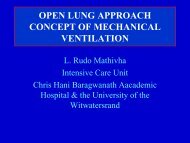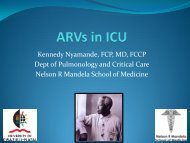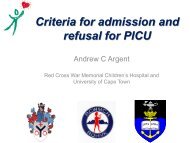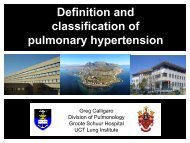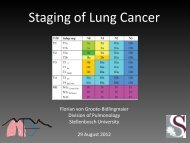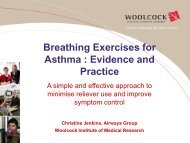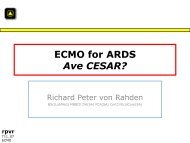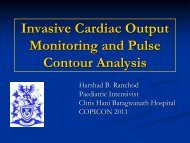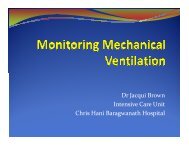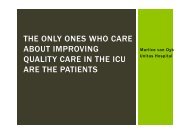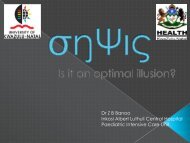Ventilator Ventilator-Associated Associated Pneumonia Pneumonia ...
Ventilator Ventilator-Associated Associated Pneumonia Pneumonia ...
Ventilator Ventilator-Associated Associated Pneumonia Pneumonia ...
Create successful ePaper yourself
Turn your PDF publications into a flip-book with our unique Google optimized e-Paper software.
VAP Rates in the USA10.03000Mean VAP rate9.08.07.0Surgical ICUs6.05.0 150025002000VAP cases per 1000 ventilator daysNumber of hospital reporting to CDC4.0Medical ICUs3.02.01.010005000.02004 2005 2006 2007 2008 20090Klompas M. Curr Opin Infect Dis 2012; 25: 176-182
Simplified Version of the CPISComponentValuePointsTemperature °C≥ 36.5 and ≤ 38.40Blood leukocytes per mm 2 ≥ 4 000 and ≤ 11 0000≥ 38.5 and ≤ 38.91≥ 39.0 and ≤ 36.02< 4 000 or > 11 0001Tracheal secretions FewModerate01LargePurulent2+1OxygenationPao 2 /Fio 2 ,mm Mg> 240 or presence of ARDS≤ 240 or absence of ARDS02Chest radiograph No infiltrate0Patchy or diffuse infiltrate1Localised infiltrate2Luna C et al. Crit Care Med 2003; 31: 676-682
Diagnostic Accuracy of CPIS: A Meta-analysisanalysisPotentially relevant papersretrieved from the databases19Detailed evaluation14Excluded based on titleor abstract5Excluded irrelevant10Assessed withQUADAS15Additional studiesidentified in reference lists11Excluded insufficient data2Included in the metaanalysis13Shan J et al. Respiratory Care 2011; 56: 1087-1094
First AuthorYearSensitivity95% CITejerina20100.450.37-0.54Pellosi20080.970.85-1.00Pham20070.330.12-0.62Veinstein20060.660.49-0.80Fartoukh20030.850.70-0.94Fábregas19990.770.46-0.95Carolina20040.410.29-0.54Luyt20040.890.80-0.94Jung20100.850.69-0.95Ramirez20080.780.40-0.97Croce20060.610.49-0.73Luyt20080.590.33-0.82Flanagan20000.580.66-0.96Pooled sensitivity = 0.65 (0.61 to 0.69)Chi 2 = 115.24; df = 12 (p
First AuthorYearSensitivity95% CITejerina20100.600.50-0.69Pellosi20081.000.86-1.00Pham20070.770.46-0.95Veinstein20060.540.37-0.71Fartoukh20030.490.32-0.65Fábregas19990.420.15-0.72Carolina20040.770.59-0.90Luyt20040.490.37-0.57Jung20100.610.39-0.80Ramirez20080.800.63-0.92Croce20060.430.33-0.54Luyt20080.750.53-0.90Flanagan20000.910.84-0.95Pooled sensitivity = 0.64 (0.60 to 0.67)Chi 2 = 114.41; df = 12 (p
First AuthorYearSensitivity95% CITejerina20101.250.76-2.07Pellosi20081094.3342.74-28019.31Pham20071.670.31-8.93Veinstein20062.290.91-5.79Fartoukh20035.381.84-15.71Fábregas19992.380.42-13/39Carolina20042.400.91-8.33Luyt20046.893.24-14.66Jung20109.022.54-31.99Ramirez200814.002.37-82.72Croce20061.180.62-2.25Luyt20084.291.13-16.31Flanagan200055.9315.35-191.33Random Effects ModelPooled diagnostic odds ratio = 4.85(2.42 to 9.71)Cochran-Q = 67.85; df = 12 (p
Diagnosing VAP in Critically Ill PatientsSepsisn=259Respiratory ICUn=82Surgical ICUn=91Emergency ICUn=86Did not meetDid not meetDid not meetcriteriacriteriacriterian=39 n=52 n=76Enrolledn=43Enrolledn=39Enrolledn=10VAPn=12Non-VAPn=31VAPn=15Non-VAPn=24VAPn=5Non-VAPn=5Survivorsn=2Nonsurvivorsn=10Survivorsn=9Nonsurvivorsn=6Survivorsn=3Nonsurvivors2n=2Su L-X et al. Am J Crit Care 2012; 21: e110-e119
ADiagnostic Value in VAPB1.00.8Sensitivity0.60.40.20.00.00.2 0.4 0.6 0.8 1.00.00.2 0.4 0.6 0.8 1.01-Specificity1-SpecificityCPISPCTWBCsTREM-1Ref linesTREM-1 + WBCsTREM-1 + CPISRef lineSu L-X et al. Am J Crit Care 2012; 21: e110-e119
Prognostic Value in VAP1.00.8Sensitivity0.60.40.2PCTCPISPCT + CPISRef line0.00.00.2 0.4 0.6 0.8 1.01-SpecificitySu L-X et al. Am J Crit Care 2012; 21: e110-e119
Quantitative vs. qualitative culture, outcome: MortalityStudy/subgroupQuantitativecultureEvents TotalQuantitativecultureEvents TotalWeightRisk ratioM-H, Fixed, 95% CIRisk ratioM-H, Fixed, 95% CICCTG 2006Fagon 2000Solé Violán 20006963102652944561899Total (95% CI)614Total events142164Heterogeneity Chi 2 = 1.70, df = 2 (P = 0.43); I 2 = 0%Test for overall effect Z = 0.94 (P = 0.35)3742094362643.3%50.8%5.8%100.0%1.02 (0.76-1.38)0.80 (0.61-1.04)1.06 (0.48-2.36)0.91 (0.75-1.11)0.1 0.2 0.5 1 2 5 10Favours quantitative Favours qualitativeQuantitative vs. qualitative culture, outcome: AntibioticStudy/subgroupQuantitativecultureEvents TotalQuantitativecultureEvents TotalWeightRisk ratioM-H, Fixed, 95% CIRisk ratioM-H, Fixed, 95% CICCTG 2006Solé Violán 2000271153654527945279559.2%40.8%1.00 (0.91-1.08)2.87 (1.14-7.21)Total (95% CI)410284 100.0%Total events286410Heterogeneity Tau 2 = 0.49; Chi 2 = 5.35, df = 1 (P = 0.02); I 2 = 81%Test for overall effect Z = 0.80 (P = 0.43)1.53 (0.54-4.39)0.005 0.1 1 10 200Favours quantitative Favours qualitativeBerton DC et al. Cochrane Database of Systematic Reviews 2012, Issue 1
Quantitative vs. qualitative culture, outcome: Durationmechanical ventilation (days)QuantitativecultureStudy/subgroup Mean SD TotalQuantitativecultureMean SD TotalRisk ratioWeight M-H, Fixed, 95% CIRisk ratioM-H, Fixed, 95% CICCTG 2006Solé Violán 20008.919.916.162.816.162.8365458.819.918.34319.2%48-.8%0.10 (-2.39, 2.59)0.70 (-0.51, 1.91)Total (95% CI)410100.0%0.58 (-0.51, 1.68)Heterogeneity Chi 2 = 0.18, df = 1 (P = 0.67); I 2 = 0%Test for overall effect Z = 1.05 (P = 0.29)-100 -50 0 50 100Favours quantitative Favours qualitativeQuantitative vs. qualitative culture, outcome: ICU stay (days)QuantitativecultureQuantitativecultureRisk ratioRisk ratioStudy/subgroup Mean SDTotalMeanSDTotalWeight M-H, Fixed, 95% CIM-H, Fixed, 95% CICCTG 2006Fagon 2000Solé Violán 200012.326.723.614.123.93.13652044512.225.122.416.328.53.13742094324.6%4.6%70.7%0.10 (-2.10, 2.30)1.60 (-3.47, 6.67)1.20 (-0.10, 2.50)Total (95% CI)Total events614 614Heterogeneity Chi 2 = 0.78, df = 2 (P = 0.68), I 2 = 0%Test for overall effect Z = 1.70 (P = 0.09)626100.0%0.95 (-0.14, 2.04)-100 -50 0 50 100Favours quantitative Favours qualitativeBerton DC et al. Cochrane Database of Systematic Reviews 2012, Issue 1
Microbial Agents Causing VAPCommon causesRare/unusual causesGram-positive cocciS. aureusS. pneumoniaeOther streptococciCoagulase neg. staphylococciAerobic Gram-negative bacilliEnteric Gram-negative bacilliE. coliKlebsiella speciesEnterobacter speciesProteus speciesCitrobacter speciesNon-termentative Gram-negative bacilliPseudomonas spp.Acinobacter spp.H. influenzaeFungiCandida speciesGram-positive bacilliCorynebacterium speciesListeria monocytogenesNorcardia speciesAerobic Gram-negative bacilliSerratia speciesHafnia alveiStentrophomonad maltophiliaBurkholderia speciesProteus speciesGram-negative cocciMeisseria speciesMoraxella speciesiAnaerobic bacteriaBacilliBacteroides speciesFusobacterium speciesPrevotella speciesActinomyces speciesCocciVeillonella speciesPeptostreptococciAtypical bacteriaFungiLegionella speciesMycoplasma pneumoniaeChlamydia pneumoniaeAspergillus species etc.Pneumocystis jiroveciiVirusesInfluenza & other resp.virusesHerpes simplex virusCytomegalovirusMiscellaneous causesM. tuberculosisJoseph NM et al. Eur J Int Med 2010; 21: 360-368
Common Causes of VAP – Bronchoscopically Confirmed CasesBacterial speciesGram-negative organismsAcinetobacter baumanniiPseudomonas aeruginosaEscherichia coliKlebisiella pneumoniaeStenotrophomas maltophiliaStreptococcus pneumoniaeBurkholderiaGram-positive organismsStaphylococcus aureusEnterococcusGram-positive bacilliFungiCandida albicansAspergillusOther candidaTotalNo. (%)20 (38)5 (9)4 (8)2 (4)2 (4)2 (4)1 (2)2 (4)1 (2)1 (2)10 (19)1 (2)2 (4)53 (102)Su L-X et al. Am J Crit Care 2012; 21: e110-e119
Gram-negative bacillusEnzymatic inactivationChange in receptorconformationβ-lactamaseFlagellumBypasspathwayDecreasedpenetrationdue toaltered porinEffluxpumpPiliGrgurich PE et al. Expt Rev Resp Med 2012; 6: 553-555
Risk Factors for MDR Pathogens Antimicrobial therapy preceding 90 days Current hospitalisation of 5 days or more High frequency of antibiotic resistance in the communityof in the specific hospital unit Presence of risk factors for HCAP:- Hospitalization for 2 days or more in the preceding 90 days- Residence in a nursing home or extended care facility- Home infusion therapy (including antibiotics)- Chronic dialysis within 30 days- Home wound care- Family member with multidrug-resistant resistant pathogen Immunosuppressive disease and/or therapyATS HAP, VAP, HCAP Guideline Am J Respir Crit Care Med 2005; 171: 388-416
The VAP PIRO Score - PrognosticationPIROelementsAdjustedOR95% CIPPIR3.81: comorbidities*: systolic BP
10093.3908076.5Mortality (%)7060504030209.8p
The VAP PIRO Score - PrognosticationUnivariate analysisRisk according toVAP PIRO scoreNo. (%)DeathNo. (%)OR(95% CI)Mild risk (0-1 point) 237 (53.7)33 (13.9)1High risk (2 points)121 (27.5)64 (52.9)6.94 (4.03-11.99)Very high risk (3-4 points)83 (18.8)66 (79.5)24.0 (12.02-48.54)Lisboa T et al. Chest 2008; 134: 1208-1216
1.00.8Mild riskSurvival0.60.4High riskVery high risk0.20.0VPO PIRO risk levels and ICUmortality in 441 patients0 4 8 12 16 20 24 28DaysLisboa T et al. Chest 2008; 134: 1208-1216
1.00.8VAP PIROScoreSensitivity0.60.4APACHE IIReferenceline0.2Comparison of VAP PIRO score &APACHE II score for discriminationbetween survivors and nonsurvivorsin the ICU in 411 VAP patients0.00.0 0.2 0.4 0.6 0.8 1.01 - SpecificityLisboa T et al. Chest 2008; 134: 1208-1216
The VAP PIRO ScorePIROcomorbiditiesbacteremiasystolic BP
Initial Empirical Therapy for VAPVAP with no risk factorsfor MDR pathogensCeftriaxoneorLevofloxacin, moxifloxacin orciprofloxacinorAmpicillin/sulbactamorEtrapenemVAP with risk factorsfor MDR pathogensAntipseudomonal cephalosporin (cefepime,ceftazidime)orAntipseudomonal carbepenem (imipenemor meropenem)orβ-lactam/β-lactamase inhibitor (piperacillintazobactam)plusAntipseudomonal fluroquinolone(ciprofloxacin or levofloxacin)orAminoglycoside (amikacin, gentamicin ortobramyicin)plusLinezolid or vancomycin (if risk factors forMRSA are present)Joseph NM et al. Eur J Int Med 2010; 21: 360-368
Short course vs. Prolonged Antibiotic TherapyOutcome/ subgroup titleNo. of studiesNo. of participantsStatistical methodEffect size28-day mortality 2 431 Odds Ratio(M-H, Random, 95% CI)Recurrence of pneumonia 3 508 Odds Ratio(M-H, Random, 95% CI)28-d antibiotic-free days 2 431 Mean Difference(IV, Random, 95% CI)ITU mortality 2 107 Odds Ratio(M-H, Random, 95% CI)Non-res. of pneumonia 1 77 Odds Ratio(M-H, Fixed. 95% CI)1.08 (0.66, 1.76)1.37 (0.87, 2.17)4.02 (2.26, 5.78)0.85 (0.37, 1.91)0.89 (0.49, 7.40)In-hospital mortality 1 401 Odds Ratio1.09 (0.71, 1.67)(M-H, Fixed, 95% CI)Recurrence - multi-resistantorganism1 110 Odds Ratio(M-H, Fixed. 95% CI)0.44 (0.21, 0.95)Duration of ITU stay 2 431 Mean Difference(IV, Random, 95% CI)Duration of hospital stay 1 30 Mean Difference(IV, Fixed, 95% CI)Duration of mech. ventilation 2 107 Mean Difference(IV, Random, 95% CI)28-day mechanical ventilationfreedays2 431 Mean Difference(IV, Random, 95% CI)Mortality-associated with VAP 1 77 Mean Difference(IV, Fixed, 95% CI)-0.01 (- 2.30, 2.27)-1.0 (-4.11, 2.11)-0.01 (-0.57, 0.55)0.47 (-0.97, 1.92)1.0 (-8.85, 10.95)Pugh R et al. Cochrane Database of Systematic Reviews 2012, Issue 2
MDR VAP suspected.Obtain endotracheal or bronchoalveolar lavage cultureAssess risk factors for MDR pathogens:Prior: antibiotics. MDR pathogen. hospitalisation, long-term care.Severe disease or late onset VAPStart empiric therapyCheck cultures and clinical response at 48 h: improvedtemperature. WCBs. Oxygen and chest x-rayNoYesWrong diagnosis, wrong drug orcomplications (e.g. empyema)De-escalate antibiotics and treat for7-8 days totalGrgurich PE et al. Expt Rev Resp Med 2012; 6: 553-555
Screened patients after daily rounds in 6 ICUs (n = 6420)Patients with ICU-acquired pneumonia (n=323)Patients analysed (n=316)Not analysed (n=7Missing variables (n=7)Without systemic steroid group (n=191 – 60%) Systemic steroid group (n=125 – 40%)NV-ICUAPVAPNV-ICUAPVAP(n=81 – 42%) (n=110 – 58%)(n=46 – 37%) (n=79 – 63%)Requiredintubation(n=46 – 57%)Oxygensupport(n=35 – 43%)Requiredintubation(n=22 – 70%)Oxygensupport(n=14 – 30%)3 lost to follow-up after hospitaldischarge (censored)0 lost to follow-up after hospitaldischargeDeaths at 28 days(n=54 – 28%)Deaths at 28 days(n=49 – 39%)Ranzani OT et al. Crit Care Med 2012; 40: 2552-2561
Corticosteroid use on Diagnosis of ICU-acquired <strong>Pneumonia</strong>Indication, n (%)Exacerbation of respiratory diseaseNeurological disordersSeptic shockLong-term use of steroidsMultiple reasonsOthersAdministered drug, n (%)MethylprednisoloneDexamethasoneHydrocortisonePrednisolonePrevalence of long-term use, n (%)41 (33)34 (27)18 (14)12 (10)11 (9)9 (7)67 (54)34 (27)22 (18)2(2)29 (23)Cumulative dose median [interquartilerange] Length of treatment (days)6 [3-10]Total dose (mg)380 [160-805]Average daily dose (mg/day) 50 [34-142]Ranzani OT et al. Crit Care Med 2012; 40: 2552-2561
1.00.9No treatmentSurvival0.80.70.6Corticosteroid treatment0.5Log-Rank test: 4.006P value: 0.0450.00 7 14 21 28Time (days since pneumoniaNo. patients at riskCorticosteroids treatmentNo treatment125191diagnosis)1081759115478135Ranzani OT et al. Crit Care Med 2012; 40: 2552-2561
Risk Factors for VAPOro-pharyngeal colonizationGastric colonizationThermal injury (burns)Post-traumaticPost-surgicalHost factorsImpaired consciousnessImmunosuppressionOrgan failureSinusitisSeverity of underlying illnessOld age (≥60 years)Presence of comorbiditiesEmergency intubationRe-intubationTracheostomyBronchoscopyNasogastric tubeIntervention factorsDuration of hospital/ICU stayMultiple central venous line insertionsSedativesStress ulcer prophylaxisPrior antibiotics/no antibiotic prophylaxisImmunosuppressives (Corticosteroids)Supine head positionJoseph NM et al. Eur J Int Med 2010; 21: 360-368
Pharmacologic-based Strategies for Prevention of VAPStrategyTopical isegananOrodigestive decontamination(topical/topical + IV antibiotics)Oral chlororohexidineAerosolized antibioticsIV antibioticsSpecific stress ulcer prophylaxis regimenShort-course antibiotic therapy(when clinically applicable)RecommendationNoNoYesNilNilNoYesEvidence level1111111Routine antibiotic cycling/rotation/heterogeneityRestricted (conservative) blood transfusionVaccines (influenza, pneumococcal)NoYesYes221Kollef MH. Surgical Infections 2011; 12: 211-220
Non-pharmacologicpharmacologic-based strategies for prevention of VAPStrategyNon-invasive mask ventilationAvoid re-intubationAvoid patient transportsOrotracheal intubation preferredOrogastric intubation preferredEarly tracheostomyRoutine ventilator circuit changesHeat-moisture exchangerClosed endotracheal suctioningSubglottic secretion drainageShorter duration mechanical-ventilationAdequate ICU staffingSilver-coated endotracheal tubePolyurethane endotracheal tube cuffSemi-erect positioningRotational bedsChest physiotherapyUse of protocols/bundlesRecommendationYesYesYesYesYesNoNoYesYesYesYesYesYesYesYesYesNoYesEvidence level122121111112111112Kollef MH. Surgical Infections 2011; 12: 211-220
186 citations14 potentiallyeligible studies6 randomisedtrialsRole ofToothbrushingversus OralCare Alone8 excluded studies1. not randomised2. designed as randomisedtrials but reported asobservational studies2. no VAP outcomes reported3. toothbrushing used inboth arms5 randomised trialstestingtoothbrushing vs.no toothbrushing1 randomised trialtesting electric vs.manualtoothbrushingAlhazzani W et al. Crit Care Med 2013; 41: e-pub
Outcome: VAPToothbrushingControlRisk ratioRisk ratioStudy/subgroupEventsTotalEventsTotalWeightM-H, Fixed, 95% CIM-H, Fixed, 95% CIPobo 2009Munro 2009Yao 2011Lorente 201215484217497282171845142473952521824.0%36.2%14.1%25.7%0.82 (0.45-1.50)1.04 (0.78-1.40)0.26 (1.10-0.67)0.88 (0.51-1.54)Total (95% CI)416412 100.0%Total events88101Heterogeneity Tau 2 = 0.12, Chi 2 = 7.81, df = 3 (P = 0.057); I 2 = 62%Test for overall effect Z = 1.13 (P = 0.26)0.77 (0.50-1.21)0.01 0.1 1 10 100FavourstoothbrushingFavourscontrolAlhazzani W et al. Crit Care Med 2013; 41: e-pub
Specific Quality improvement interventions Use evidence-based bundle elements Insure local resources capable of supportingselected bundle elements Do not become bound to any single bundle ifit is found to be ineffective or impractical toimplementMeasurable Outcomes Focus on compliance with process elements Select limited but clinically relevant outcomemeasures (e.g. VAP incidence, antibiotic use,duration of ventilation) Guard against reporting biases, especiallywhen using before-after or time-senesmethodsAchievable Programme Target one problem or outcome at a time Do not overreach local resource capability Develop a local approach to qualityimprovement that can be applied tosubsequent problems or outcomesRelevant Quality Improvement Programme Target problems or outcomes that havedirect significance and consequences topatient care (e.g. improved compliance withsedation holiday protocols) Update quality improvement programmessuch as new information, technology, orresources become available Employ periodic reviews of all qualityimprovement programmes by unbiasedindividuals to evaluate their success andcost-effectivenessTime-Bound Programme Employ discrete time periods for theimplementation and evaluation of eachquality improvement programme Develop objective parameters to determinewhether quality improvement interventionsshould continue, be modified, ordiscontinued Avoid having quality improvementprogrammes in place without definite periodsor reevaluationKollef MH. Crit Care Med 2012; 40: 271-277



